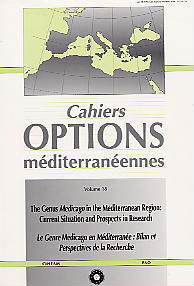| Article précédent | p. 151-160 | Article suivant |
Ten years of research on Medicago at 'Instituto di Ricerche sul Miglioramento Genetico delle Piante Forraggere del CNR di Perugia'
In the last 10 years the Istituto di Ricerche sul Miglioramento Genetico delle Piante Forraggere (IRMGPF)'s research activity, has been moving gradually from traditional plant breeding to biotechnologies. Regarding traditional plant breeding of Medicago sativa the Institute has developed researches on 2n gametes in alfalfa and utilization of annual species of Medicago in genetic improvement of lucerne. Data on the presence of 2n gametes in diploid populations of Medicago sativa complex have been used either to increase the frequency of 2n gametes production, or to determine the mechanisms responsible for the formation of such gametes. The utilization of annual species of genus Medicago aimed to introduce in alfalfa traits for resistance to biotic and abiotic stresses. The IRMGPF has begun different biotechnology researches. Two of these are the somaclonal variation in Medicago sativa in order to discover interesting phenotypes for quantitative traits and in vitro selection to increase resistance to Fusarium wilt. The transfer of traits from the wild Medicago species has been carried out by somatic hybridization and embryo rescue. Embryo culture has been successful in producing hybrids between M. sativa and M. rugosa, while protoplasm fusion made obtainable hybrids M. sativa + M. coerulea and M. sativa + M. arborea. Somatic hybrid plants between M. sativa and M. coerulea have been RFLP finger printed to establish their nuclear composition. Furthermore, the RFLP's have been used to estimate the heterozigosity level of alfalfa populations and have been adopted for variety identification in M. sativa. Another research is the improvement of forage quality by genetic transformation. After preliminary experiments to set up the right working conditions for recovering transgenic plants at high frequency, goals are to produce bloat-safe lucerne genotypes with increasing amounts of sulphurous aminoacids.
- [ Afficher ]
- [ Télécharger ]
- [ Exporter la citation ]
Vous pouvez télécharger la citation au format :
- [ Imprimer ]
-
Mots-clés
CULTURE D'EMBRYON, GAMETE, ITALIE, MARQUEUR GENETIQUE, MEDICAGO SATIVA, RECHERCHE, SELECTION IN VITRO, VARIATION SOMACLONALECiter cet article
Bellucci M., Arcioni S. Ten years of research on Medicago at 'Instituto di Ricerche sul Miglioramento Genetico delle Piante Forraggere del CNR di Perugia'. In : Genier G. (ed.), Prosperi J.M. (ed.). The Genus Medicago in the Mediterranean region: Current situation and prospects in research . Zaragoza : CIHEAM, 1996. p. 151-160. (Cahiers Options Méditerranéennes; n. 18). Meeting of the Mediterranean Working Group on Medicago of the FAO/CIHEAM Inter-Regional Research and Development Network on Pastures and Fodder Crops, 1995/10/19-22, Hammamet (Tunisia). http://om.ciheam.org/om/pdf/c18/96605770.pdf



